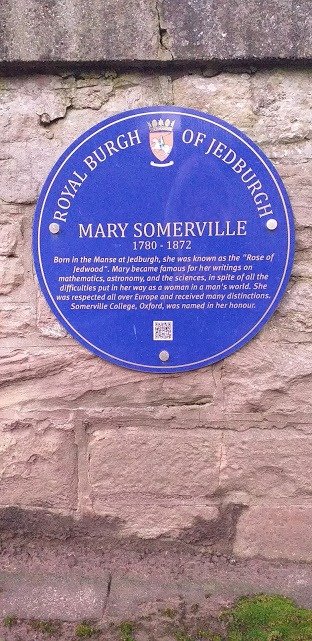What do Oxford University, a lunar crater, an island in Canada, an asteroid and the Royal Bank of Scotland £10 note have in common?
Mary Somerville, of course!
A brilliant astronomer, mathematician, geographer, renowned science popularizer and an advocate for women’s education and women’s rights, Mary Somerville is often referred to as The Queen of the 19th Century Science. And no wonder! It is to describe Somerville’s work that the word scientist (as opposed to a man of science) has been used for the first time. Mary Somerville became the first female member of the Royal Astronomical Society. Her science books became international bestsellers and were translated into German, French and Italian.
It’s been fascinating to learn about Mary Somerville’s life and work, read her memoirs and visit her birthplace. Join WonderDome as we are discovering the story of this extraordinary woman.
The life of Mary Somerville

Mary Somerville (nee Mary Fairfax) was born in 1780 in the small town of Jedburgh, Scottish Borders. She was the 5th of 7 children of the vice admiral Sir William Fairfax and Margaret Charters. As a girl, Mary Fairfax received practically no formal education. Mary’s family didn’t approve of her reading and learning because it was a common belief that such “unladylike” occupation was bad for a girl’s health and character. Mary studied languages, Geography, Astronomy and Math in secrecy, often staying up all night.
Luckily for Mary, the Fairfax family spent a lot of time in Edinburgh. It was there that she got acquainted with many mathematicians and men of science of the time. Some of them recognized Mary’s talent and encouraged her to study. Several of these acquaintances later became Somerville’s mentors and lifelong friends.
Despite her extensive studies, Mary enjoyed a society life too. She was married twice. First, to her second cousin Samuel Greig, a Russian consul in London. And later to her first cousin, doctor William Somerville. The first union was not a happy one. As Mary Somerville writes in the “Personal Recollections”, her husband ”had a very low opinion of the capacity of my sex”. When Samuel Greig died, Mary inherited a small fortune that gave her the freedom to continue her work.
By contrast, Somerville’s second husband was very proud of his wife’s occupation and supported Mary in her research. When in 1826, Mary, age 45, published her first original paper “The Magnetic Properties of the violet rays of the Solar Spectrum”, William Somerville presented the paper at the Royal Society meeting.
First publication
“The magnetic Properties…” is quite an interesting paper written in the spirit of the science of the time. In it Mary tried to find the connection between different forces of nature, namely light and magnetism. She used a prism to split the light into different colours and then observed how they affected a metal needle. Somerville concluded that after the exposure to the VIOLET light the needle became magnetized. That idea, of course, later turned out to be wrong. Somerville burned all her copies of the manuscript. Interestingly, a film director Mike Leigh chose to depict that particular experiment in his 2014 movie Mr.Turner.
Legacy
*
Thanks to Mary Somerville the English speaking world became familiar with one of the most important scientific works of all times, the ”Mecanique Celeste”, by the French mathematician and astronomer Pierre-Simon Laplace. “Mecanique Celeste” uses complicated mathematical apparatus that in Somerville’s time most English scientists were unfamiliar with. Mary not only translated the 5 volume disquisition, but also transcribed the math and complimented the text with her own annotations and diagrams.
*
At the age of 54 Somerville published a popular science book “On the Connexion of the Physical Sciences”. The book instantly became an international bestseller and had many editions. In the 6th edition of the “Connexion” Mary talked about the “defective” observational tables of planet Uranus. She wrote that if the tables were correct, that meant the unseen body, possibly a planet, disturbed the motion of Uranus. In the edition 8, published after the discovery of Neptune, Somerville mentioned that her prediction came true.
On the 92nd year of her life, just days before her death, Mary Somerville wrote:
“I regret that i shall not live to know the results of the expedition to determine the currents of the ocean; the distance of the Earth from the Sun determined by the transit of Venus…”
More on Mary Somerville
- Read Personal recollections, from early life to old age, of Mary Somerville : with selections from her correspondence, an autobiography published after Mary’s death by her daughter Martha Somerville
- Watch the Royal Society talk Mary Somerville and the Empire of Science in the Nineteenth Century by Prof. Jim Second
- Visit our star dome or send your questions to our planetarium team

